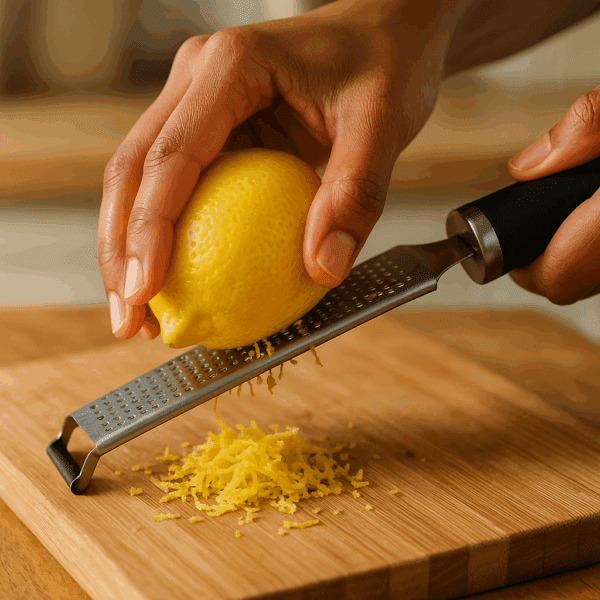Let me ask you something—have you ever made a dish that tasted… fine, but not fabulous? Like, it should have worked, but somehow it just didn’t hit? Chances are, it was missing one magic ingredient: acid.
You see, acid in cooking is like that best friend who tells it to you straight. It sharpens, it lifts, it balances out the richness. And once you get comfy cooking with citrus and vinegar, I swear—it’s a total game changer. So let’s talk about how to use vinegar in cooking and make your food sing with brightness and depth, without making it sour or overpowering. Because when you learn to layer in acid? Your dishes come alive.
Why Acid Matters in Cooking

Acid isn’t just about tangy flavor—it’s about how to balance flavor in food. If you’ve ever heard the phrase “salt, fat, acid, heat,” you know what I mean. Acid helps cut through richness, enhances natural sweetness, and brings out complexity in even the simplest dish.
- Scientifically, acid affects pH, which can tenderize proteins and brighten colors (like vibrant greens in spinach or kale).
- Sensorially, it brings that lively zing that makes your taste buds perk up. Ever had soup that felt flat? A splash of vinegar at the end can brighten flavor in seconds.
- Emotionally? It just makes food more exciting.
The Best Vinegars for Cooking (And When to Use Them)

Not all vinegars are created equal. And trust me, I’ve ruined a few pan sauces in my day learning this the hard way. Here’s a little cheat sheet to help you navigate vinegar types for cooking:
- Organic Apple Cider Vinegar – Great in dressings, soups, and even as an apple cider vinegar marinade. Adds complexity without harshness.
- Napa Valley Naturals Organic White Wine Vinegar – Light and bright. Perfect for vinegar for seasoning or acid in salad dressing.
- Colavita Aged Balsamic Vinegar of Modena – Sweet, tangy, and thick. Amazing over roasted veggies, beans or meats. To me, balsamic vinegar for flavor is a must-have. One way to use balsamic (that may sound strange, but is actually good), is with curries. I guess in some ways, it’s like tamarind sauce which also pairs exceptionally well with curry.
- Marukan Seasoned Rice Vinegar – Mild and slightly sweet. Works beautifully in stir-fries and Asian sauces.
👉 Tip: Always taste your vinegar before using. Some are sharper or sweeter than others. Keep experimenting with your favorite meals so you can master when to add vinegar in cooking to avoid overpowering a dish.
Cooking with Citrus: More Than Just Lemon
Now let’s talk citrus. Cooking with lemon juice and cooking with lime juice gets a lot of attention, but orange and grapefruit, deserve space in your kitchen too.
- Lemons vs. Limes – Lemon is bright and floral; lime is sharper and more assertive. Learn the nuance in lime vs lemon cooking. Use lemon for Mediterranean or baking; lime for tacos, Thai, or Caribbean.
- Zest vs. Juice – Zest brings pure citrus oil and flavor without the acidity. Great for baked goods or creamy sauces.
- Orange and Grapefruit – These add sweetness and roundness. Try cooking with grapefruit if you want something truly special.
👉 Pro tip: The key with zesting is to not get the white stuff under the peel (called the pith) from your citrus into the zest, as that’s what causes bitterness. Don’t go over the same spot on your citrus multiple times – once is good enough.
Zest, All Day Long: Bright Ideas for Every Meal

Breakfast: Sprinkle citrus zest over Greek yogurt with berries, fold it into pancake batter, or stir it into muffin mix for a bright, fresh start.
Lunch: Add zest to hummus, grain bowls, or vinaigrettes for salads—it sharpens flavors without overpowering.
Dinner: Mix lemon zest into breadcrumb toppings for pasta or casseroles, finish roasted veggies, or grate it over grilled fish for a final flavor pop. Fish and zest are one of my favorite secrets.
- Lemon zest on roasted broccoli or carrots
- A splash of Bragg Organic Apple Cider Vinegar in lentil soup
- Colavita Balsamic Vinegar reduction drizzled over grilled chicken
- Lime juice over black beans and rice
When to Add Acid (Timing Is Everything)
Knowing how to finish a dish with acid is just as important as knowing which kind to use:
- Early in cooking – Helps with adding acid to braises, marinades, or soups. But go easy—it mellows out over time.
- At the end – To finish a sauce, soup, or stir-fry. A splash of acid right before serving can lift everything.
- As a garnish – A drizzle of lemon juice or vinegar on roasted veg? Try citrus zest on roasted vegetables or a balsamic splash.
A Citrus Squeezer is my secret weapon for quick, mess-free juicing.
Bright Flavor Combos You’ll Love
Here are a few tried-and-true vinegar and herb pairings and citrus pairings in savory food I use on repeat:
- Lemon + Thyme – Perfect for chicken or roasted potatoes.
- Lime + Cilantro – Hello taco night. A classic lime and chili flavor combo also slaps.
- Lime + Butter – Great for pancakes!
- Rice Vinegar + Sesame Oil – A stir-fry dream.
- Grapefruit + Mint – Great in salads or chilled soups.
- Lemon or Lime over Melons or Fruit Salad – combine with cardamom for a special treat
- Apple cider vinegar + ginger – Great with mayo based dishes, like pasta.
Cooking Mistakes to Avoid with Acid
Let’s be real—it is actually very easy to add too much acid. Learn these cooking acid do’s and don’ts:
- Don’t go overboard. Too much acid = mouth-puckering and harsh.
- Balance it with salt and fat. Acid is powerful, but it needs backup singers.
- Don’t use low-quality bottled citrus juice. Just… don’t.
- If it tastes too sharp, add a touch of honey or maple syrup to mellow it.
Chef Sam’s Favorite Acidic Finishing Touches

Here are a few of my go-to moves when a dish needs a little glow-up:
- Lemon zest on roasted broccoli or carrots
- A splash of Bragg Organic Apple Cider Vinegar in lentil soup
- Colavita Balsamic Vinegar reduction drizzled over grilled chicken
- Lime juice over black beans and rice
How to Stock Your Kitchen with Acid Powerhouses
Want to build your own acid arsenal? Here’s what I always keep on hand:
- Vinegars: Apple cider, white wine, balsamic, rice, and sherry—check any good cooking vinegar chart to expand.
- Citrus: Lemons, limes, and oranges (check fridge-stable citrus storage hacks to keep them fresh longer)
- Tools:
- A good Citrus Squeezer
- Bormioli Rocco Swing Top Glass Bottles for your finishing oils and vinegars
So what’s the moral of the story? Acid isn’t an afterthought—it’s the secret weapon of how to make flavors pop. Once you start playing with vinegars and citrus on purpose, not just as a garnish, you’ll start flavor layering with acid like a chef. And your food? It’ll sparkle.
Try this: Next time your dish tastes just okay, hit it with a tiny splash of lemon or a few drops of vinegar. Then taste again. That “wow” moment? That’s how acid boosts flavor.
Now go make your food bright, bold, and absolutely delicious, and share your zesty wins with me on Instagram @ChefSamanthaGoerge





Leave a Reply